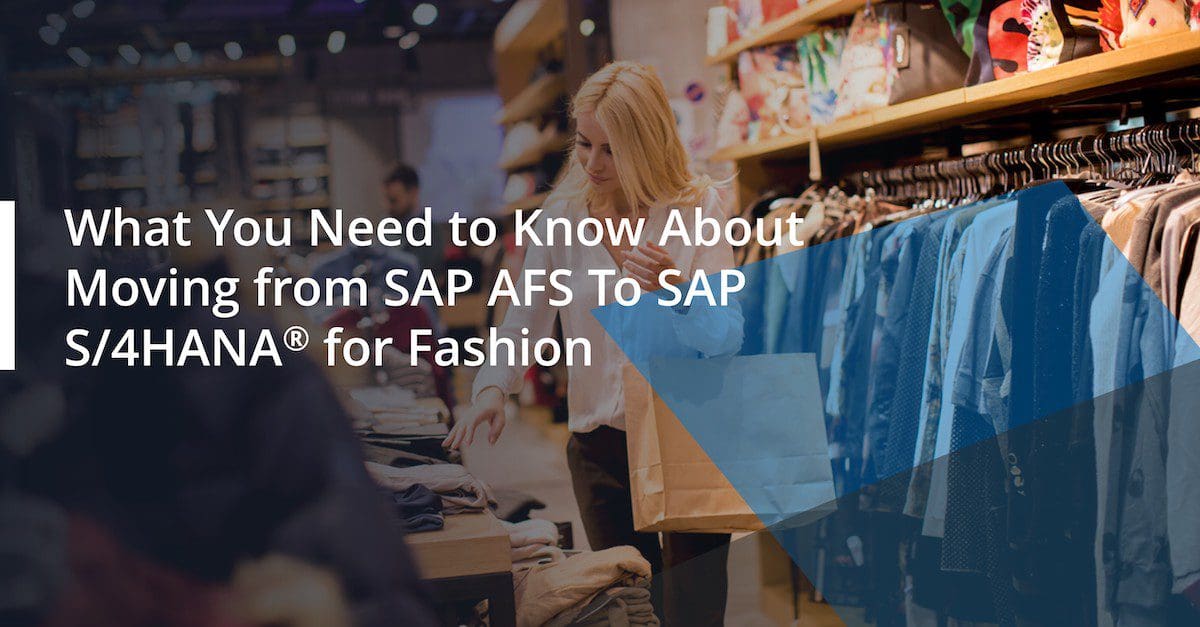With SAP AFS support ending in 2027, most customers are wondering – when not if – they will implement SAP S/4HANA®.
Let’s look at how a fashion company made the move, along with what new capabilities SAP S/4HANA delivers to meet the new demands of the digital economy.
A Customer’s Transformation Journey: SAP AFS to SAP S/4HANA for Fashion
An iconic American retail company took a major step in its transformation journey by migrating from SAP AFS to SAP S/4HANA Fashion and Vertical Business.
The fashion company has been steadily growing in its business and was looking to implement industry best practices in its retail, wholesale, and e-Commerce business. The transformation hoped to address some of the key challenges across their business, including:
Inability to Support Growth
SAP Apparel and Footwear Solution (AFS) was unable to scale with the company’s needs, leading to constrained business growth. The company required a backend that would provide omnichannel capabilities and the flexibility to adapt to dynamic market conditions.
Lack of Digital Capabilities on AFS
Inability to support the levels of digitization necessary to modernize, scale, and provide the agility needed to future-proof the company’s manufacturing, retail, and wholesale businesses. The company needed a solution that would act as a digital core, enabling it to rapidly expand as requirements evolved.
Inability to Keep the Core Stable While Innovating
The existing legacy system was nearing the end of its life and proved difficult to upgrade and perform regression testing while maintaining a stable core. The company required a solution that would provide a stable core while simultaneously rolling out new innovations.
Meeting the Challenge
The company used Rizing’s Future Reference Solution (FRS) to build the blueprint, which helped migrate from SAP AFS to S/4HANA. This fit-for-purpose SAP S/4HANA for Fashion solution served as a working prototype, helping the company review desired future processes and build a better design template. Multiple workshops were organized to build a design template.
The Future Reference Solution (FRS) is based on attune Fashion Suite™, which accelerated the build process once the detailed design was complete. The solution was implemented across retail and wholesale operations including 30+ retail stores. The next phase of the project includes the roll-out across its manufacturing operations as well as integration of eCommerce.
This approach helped the company migrate from AFS to S/4HANA by providing:
- A detailed gap analysis that prioritized high-level solution gap identification and analysis for the blueprint.
- A better understanding of the Level of Fit: a working template to test the viability of S/4HANA Fashion for the fashion brand.
- A clear way to determine ERP scope which helps identify potential clusters for harmonization and establish the future state of their SAP S/4HANA Fashion solution.
- A method to accelerate Blueprint Planning: The company was able to start the blueprint phase with an enriched, better-defined template, supported by high-level documentation covering key areas such as “TO BE” business processes, enhancements, and integrations.
- Fashion-specific functionality that uses the attune Fashion Suite™, Rizing’s pre-configured accelerator, which brings proven practice processes out of the box and keeps brands in line with SAP S/4HANA practices.
- A template that can be reused in the blueprint phase to increase their delivery quality, expedite the timeline, and minimize efforts during the entire course of the program.
Migration Options: From SAP AFS to S/4HANA Fashion
For many customers, an SAP S/4HANA program starts with a debate on how to approach the project and what options to consider. Based on our experience, we recommend centering your program on the company’s vision, readiness to change, and business transformation capabilities as these play a much bigger role than any technology aspects.
The way you set up and manage your project will define your ability to turn SAP’s innovations to your company’s advantage. This approach will also decide if in a few years from now, your new system will be susceptible to the disruptive forces in the retail industry – or if it will provide the agility and speed to outpace the competition.
Here are a few options that we recommend:
- To minimize the risk of an ERP rollout for fashion companies, fashion companies can use Rizing’s Future Reference Solution (FRS), which is designed to provide fashion brands a re-usable, personalized template of SAP S/4HANA for Fashion, using our rapid-deployment solution – attune Fashion Suite™.
- RISE with SAP helps in reducing high upfront investments and overall TCO. It provides digital transformation as a service model, where the cost of licensing, hosting, and support of your ERP will be covered under one contract by a single subscription fee from SAP. If you are an AFS customer, there are two options:
- Migrate your existing AFS landscape to RISE as system migration and make use of the technical platform capabilities to enhance your digital offering.
- Start a new S/4HANA greenfield project as part of the RISE program, which would be similar to a greenfield S/4HANA on-premise implementation but with added advantages of the RISE program as mentioned earlier.

